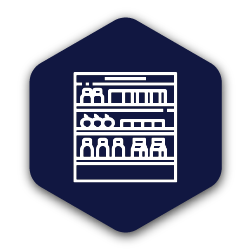If you're a retailer, you’ve no doubt heard about planograms and how they can transform your retail optimisation efforts. These powerful tools offer visual representations that you can use to plan, communicate, implement and maintain your merchandising strategies in-store. They also describe the placement and positioning of your products and the number of facings allocated to each one.
So when you consider the raft of benefits that planograms have to offer, it makes complete sense then why they must be data-driven.
A planogram aims to increase your sales and profitability by ensuring your shelf displays offer the right selection of products to reach your shoppers at the right place and at the right time. It also helps you to contribute to creating a more pleasant in-store shopping experience that satisfies your customers’ needs and motivates them to return.
The data a planogram uses - data including sales, units, SKU, fixture information and more - allows it to meet the important benefits and objectives, as described above. That also speaks to why it's worth using planograms in the first place - it makes sound business sense. But there is far more to the basic commercial logic and simple advantages of having data-driven planograms at your disposal. And that is what we unpack in this article, digging deeper into why planograms are worth implementing in your business.
Why should retailers use planograms?
When the conversation turns to planograms, the first question to address revolves around 'why'. Why should you use planograms? Why are they so important? And why do they depend on data as much as they do? Addressing the ‘why’ straight out of the gate makes sense considering that if you don't know why you're employing a strategy, technique or tool, it's pretty easy to lose focus.
As we mentioned above, there are clear reasons why making use of planograms is such a good idea. However, that doesn't mean we shouldn’t explore these reasons further. After all, simply stating that a planogram can increase your sales and profitability is one thing, demonstrating it is completely another.
To prove this, we must explain just how they’re able to achieve that. Here’s how:
- Maximise your sales per square metre
Planograms help you to provide more space for your best-selling products and reduce the space given to your worst-performing products.
By understanding product and category performance, you can quickly understand which of your products are performing well and which ones aren’t. In essence, planograms allow you to spot the winners and eliminate or phase out the losers. This allows you to use your shelf space strategically, choosing where to place the right products, allowing you to get the most out of your space, dramatically improving your ROI.
Let’s say, for example, you want to grow your House brand. In this instance, you’d want to give more space to the brand and place its products in the best positions on-shelf. This means more customers will see it, naturally, because you’re placing it in a prime position - next to category leaders and well-known brands. By doing so, you’re also changing the perception your customers have of your house brand - bolstering its prominence and, eventually, your bottom line.
- Create an improved shopping experience
By defining a product flow based on the consumer decision tree, you can ensure that when a customer shops in your store, it’ll be easier for them to find what they want, quickly and easily. This can also lead to your customers spending more time in your store, which equates to more sales in the long run.
It’s worth pointing out that in creating a product flow and standardising it across your stores, you create consistency, and people love consistency. This also feeds into that pleasant shopping experience boosting your shoppers’ impression of your store, your offerings and your brand reputation. Your customers will be more likely to choose you over a competitor as they become accustomed to being able to find what they want when visiting your store without having to ask for directions or for assistance.
Since we’ve looked at how planograms can assist with your retail optimisation efforts, now let’s consider what happens when you don’t have planograms in place.
- Frustrating shopping experience: Planograms dictate and organise your products and categories into a logical flow, informed by data, thereby reducing customer frustration. Imagine trying to create a product flow in your store through guesswork alone - not easy. Place yourself in the shoes of your customers and attempt to shop your store when it’s not laid out logically - you’ll soon give up in frustration.
- Lost sales: If you’re not using data-driven planograms to inform product and brand placement, you’re not giving your best-performing products the shelf space they deserve. Meanwhile, you’re poor-performing products are taking up too much space, hogging valuable shelf real estate and hampering your sales opportunities.
- Out of stocks and incorrect stock orders: By not giving each product the space it deserves, based on its performance, you’re likely to soon find yourself running out of stock. As customers grab the limited stock of top-performing products, while ignoring the poor performers, in no time, you’ll find yourself staring at empty shelves and irate customers.
Planograms are excellent at estimating just how long a product supply will last before running out, allowing you time to ensure that you have an adequate inventory supply on hand. Also, you could end up ordering too many of the wrong products, which leads to dead stock, spoiled produce and a storeroom bursting at the seams.
- Breakdown in relationships: When previously agreed upon category objectives are not implemented in-store, supplier relationships can head south - quickly. Planograms will ensure that you meet your product objectives and that the brands that deserve exposure they’ve been promised without compromising on your in-store goals.
Planograms allow you to justify and rationalize spacing decisions to suppliers - after all, the numbers in data simply don’t lie.
As for who should invest in planograms (and by association a category management solution) we’d recommend that every retailer considers implementing these category management essentials - if they’re not doing so already.
It doesn’t matter how many stores you have or how tight your budget is. If you’re serious about getting the most out of your retail efforts and you want to be successful in the long-term, investing in planograms isn’t a nice-to-have; it’s an absolute must.
Thankfully, there are plenty of options to match your goals, objectives and budget. Take, for example, DotActiv. We have three paid software editions - Lite, Professional and Enterprise which all cater to the different goals or challenges that you may face.
When discussing a category management solution with you or other prospective clients, we consider each of your goals and unique challenges before recommending any solution. After all, the solution we provide, be it software or services, needs to match your circumstances and find answers to what you want to achieve.
With the right category management solution, you can remain competitive in the ever-changing and evolving retail industry. Why wouldn’t you want that?
What data should retailers use to build planograms?
Let’s look now at the nature of the data you should be collecting, curating and using to inform your planograming efforts.
It’s worth pointing out that the above benefits and consequences discussed already all relate to when you’re using data to build your planograms and which data you’re putting to work.
Without the correct data, all you have is a pretty picture of how your shelf should look - nothing more. It’s nice to look at, be it on a computer screen or even on the shelf in a store, but the value stops there. Without usable, accurate data, products will almost always end up in the wrong place on the shelf, which means you’ll lose out on sales and frustrate your customers. In fact, you’ll be doing more harm than good.
But what data and other critical information do you need to use to build a planogram? It’s all good and well talking about the importance of data but it doesn’t help if we don’t mention which specific you need to use.
Below is a breakdown:
- Sales and Unit data
To create the best possible planogram, DotActiv’s space and category planners pair their extensive knowledge about a product with sales data for the category. That includes monetary sales and the number of units sold over a specific period.
Sales history also provides important information about the product. This includes whether the product is purchased more on a seasonal or generally frequent basis throughout the year. We prefer (and recommend) a 6-month period or year-on-year to make accurate calculations and comparisons to aid in determining sales and unit growth projections or goals. Period data needs to reflect the most recent data to ensure that the information presented is both accurate and current. If you have access to external market data, you can use it in conjunction with your internal sales data.
Sales and unit data are necessary to determine your days of supply (DOS), which you can use to determine how long a particular item will sit on the shelf before it sells out.
Let’s say, for example, you stock perishable items. By determining your DOS, you can ensure it sells out appropriately. You can also better manage the turnover of slow-moving items, which reduces the problem of having your capital tied up in idle stock.
Furthermore, DOS is pertinent in helping you determine how often the stock will need to be replenished. With sales data, you can obtain a guideline on the deserved space allocation that each SKU or brand should obtain within a shelf plan.
- Category Role and Hierarchy
By categorising products into a hierarchy, you can create a product structure to group products based on either application/usage or by brand. This is your consumer decision tree, which we mentioned earlier in the article.
This process eases any space or category planning process and provides more insight into how your customers shop and view categories.
For example, you might want to have your premium SKUs in the front of the run to entice customers through the aisle. Or, have your house brands in line with the competing private label brands or at eye level to encourage customers to choose your brands instead.
Your hierarchy and price may also tie in with your merchandising principles, which determine the location, aesthetic, and flow of the planogram. A combination of the correct price, hierarchy, and category flow will ultimately provide you with the perfect recipe for increased revenue.
Determining the role of a category can be very useful to understand how a consumer behaves and it will affect the positioning of products on a shelf.
There are four major consumer-based category roles: Destination, Routine, Seasonal, and Convenience. It’s worth noting, as Sue Nicholls, president of CMKG points out, that categories are not all created equal so you do need to be mindful when assigning roles.
- A Range
A range is an assortment of products that matches the category. A range is important since it determines how many products can fit on the shelf and if the products on the shelf will sell or not.
- SKU Information and Product Attributes
When building your planogram in DotActiv, you’ll need as much information about your products as you can obtain. That includes the following:
- Barcode; Product ID; Description; Supplier; Brand and Size; and
- Product Images; Product Dimensions; Product Status; Price; and Colour.
These attributes will help you understand the consumer decision tree and hierarchy in accordance with shopping behaviour towards a particular category. The attributes also help dictate your category strategy.
For example, you can arrange products based on function and price or colour block products for a visual impact on the shelf. Having the necessary product knowledge and understanding the role of a product in a category will allow you to create logical product flows (merchandising mix) that align with the behaviour and expectations of your customers.
- Fixture Information
Besides the product information, you also need to collect information about the fixtures that you plan to use in-store.
This includes fixture types (shelves, hanging bars, hanging pegs, baskets) and fixture dimensions (floor to shelf height, shelf height, width and depth).
The above-mentioned information is essential for planogram building as the combination of this data shows you determining factors such as days of supply, capacity, various contributions, profits, weekly movement, and other selected KPIs that you can use to position your products on the shelf.
Conclusion
Planograms should always form a key part of your retail business if you want to remain relevant and competitive. However, there’s much more to using planograms than simply creating attractive shelf layouts if you’re hoping to remain top-of-mind amongst shoppers. The planograms you implement in-store must be populated with the correct relevant data if you’re going to get the most out of them.
With the correct data, you can provide all of your best-performing products with the shelf space they deserve, without sacrificing vital space to poorer performers, or hurting your supplier relationships. With correct data, you can create a shopping environment that customers will want to visit again and again. More importantly, with the correct data, you can build planograms that lay the foundation for you to become the go-to retailer for those products you offer.
Are you in need of a category management solution? Why not use one of DotActiv’s three paid software editions to build your first planogram? Alternatively, book a complimentary consultation with a DotActiv expert to understand more about how we can deliver performance-enhancing planograms for your business with our Planogram Development service.
About the contributors
Jolene de Witt joined DotActiv in mid-2021 as a retail space planner, working on a variety of ad-hoc accounts. She has since moved over to our Dis-Chem account where she is working as a category planner, delivering our end-to-end category management services. She has a Bachelor of Commerce (Honours) in Strategic Management from the University of Johannesburg.
Palesa Mnguni joined DotActiv in 2021 as a space planner on our ad-hoc accounts where she delivers a variety of category management services, including data-driven planograms. She has a Bachelor of Commerce (Honours) in Strategic Management from the University of Johannesburg.
Sonja Roos joined DotActiv in 2019 as a space planner, working on Makro's General Merchandising account. She has since been promoted to account manager. She has a Bachelor of Arts in Fashion Media from STADIO's School of Fashion, formerly known as LISOF and a Bachelor of Philosophy (Honours) in Marketing Management from the IMM Graduate School of Marketing.
Zandre Prins joined DotActiv in 2021 as a space planner where she worked on a variety of accounts delivering our category management services. She has since moved over to our Wellness Warehouse account where is works as a category planner. She has a Bachelor of Commerce in Marketing from the University of the Free State.





